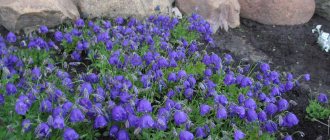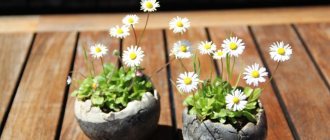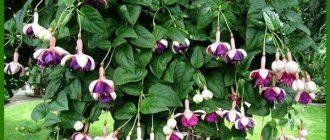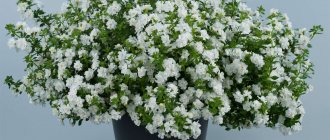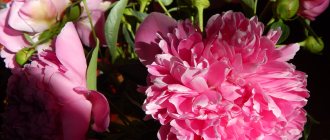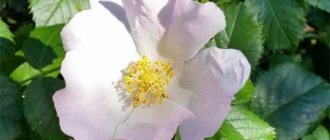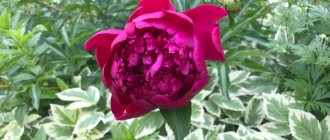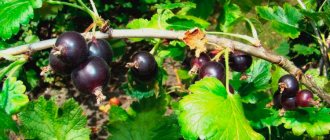Author: Elena N. https://floristics.info/ru/index.php?option=com_contact&view=contact&id=19 Category: Garden plants Published: February 26, 2018Last edits: November 04, 2020
- Rules of care
- Swamp cornflower (Leucanthemum paludosum)
Leucanthemum (Latin: Leucanthemum) is a genus of herbaceous perennials and annuals of the Compositae, or Asteraceae, family, which was previously classified in the Chrysanthemum genus. However, unlike chrysanthemums, nivyaniki do not have a characteristic aroma and are not covered with grayish hair. According to various sources, the genus Nivyanik includes from twenty to seventy species. The scientific name “leucanthemum” is translated from Greek as “white flower”, and the Russian “nivyanik” is a derivative of the word “niva”. Most species of cornflower come from Europe and temperate regions of Asia, although cornflowers are also found in North America, New Zealand and Australia. In culture, cornflower is more often called garden chamomile and is widely used in landscape design and landscaping. In this article we will tell you what the cornflower looks like, how it reproduces, when to plant cornflower seedlings, and when to sow it in open ground and how to care for it in the garden.
Planting and caring for cornflowers
- Planting: sowing seeds directly into the ground - at the end of May, sowing seeds for seedlings - at the end of February or early March, planting seedlings in the garden - in May.
- Flowering: from early July to September.
- Lighting: bright sunlight.
- Soil: neutral or slightly alkaline, in an area with deep groundwater.
- Watering: during the rooting period, seedlings are watered frequently, but then watering will only be required during periods of prolonged drought. Water consumption per m² is 10 l.
- Top dressing: humus, peat and compost are added to the soil annually, and in mid-spring the soil is fertilized with a solution of Nitroammofoska or mullein.
- Reproduction: by seeds and dividing the bush.
- Pests: aphids, thrips, slobbering pennies and chrysanthemum miners.
- Diseases: affected by powdery mildew, gray mold, blight, stem rot, rust, fusarium and bacterial canker.
Read more about growing cornflower below.
Growing cornflower from seeds
Growing cornflower through seedlings has one advantage: such plants will begin to bloom already in the current season. Seeds are sown for seedlings in the last days of February or the first days of March. For sowing, you can take absolutely any containers (boxes, cups, bowls, etc.), because in the future the seedlings will need to be picked. However, to make it easier to control soil moisture, it is better to take a shallow container for sowing. The containers are filled with a ready-made soil mixture intended for planting flower seedlings, but if desired, you can take a mixture consisting of sand and high-moor peat. Before sowing, the soil mixture and container must be disinfected using a solution of potassium manganese. To begin with, you should make a good drainage layer at the bottom of the container, which is filled with soil mixture. The container should not be filled to the top, 20–30 mm below the edge. The surface of the substrate should be leveled, after which you need to evenly distribute the seeds, which are buried only 10 mm and sprinkled with a thin layer of soil mixture. Crops should be moistened with a fine spray.
There is no need to cover the container, but it is moved to a warm place (about 22 degrees). After the first seedlings appear, the container should be moved to a cooler place (from 18 to 20 degrees). When the plants are 4 weeks old, they should be fertilized with a weak solution of mullein. Seedlings are picked at one and a half months of age; for this, they are planted in individual cups, which should be filled with a soil mixture of the same composition, but a little humus should be added to it. When choosing cups, you should take into account that seedlings will grow in them before transplanting into open soil. When several days have passed after transplantation, the plants will need one more feeding, for which an organic solution is used. It should be noted that the interval between these two feedings should be approximately 20–30 days. Seedlings are planted in open soil in May, but only when the threat of spring frosts has passed. However, before planting, the plant should be hardened off for 15 days.
The diameter of the planting holes should reach 0.3 m, the distance between them directly depends on the variety of cornflower and varies from 0.3 to 0.7 m. The distance between the rows should be at least 20 centimeters. Before planting, you need to put 20 grams of complete mineral fertilizer, as well as 300 to 400 grams of compost or humus, at the bottom of the hole. The seedlings are planted together with a clod of earth, and the holes are filled with nutritious soil. Planted plants need abundant watering. After the liquid is completely absorbed into the soil and its surface dries out a little, the area is covered with a layer of mulch, which is a mixture of saltpeter and sawdust (20 grams of saltpeter per 1 bucket of sawdust).
Botanical description
The flower is a plant with red rhizomes, straight, leafy, slightly branched stems from 30 to 120 cm high and entire, oblong-lanceolate, dark green, lobed or crenate leaves along the edge. Depending on the type, nivberry leaves can be stem or basal. Large flowers with a diameter of 6 to 12 cm, absolutely similar to daisies, are actually basket inflorescences consisting of yellow tubular flowers surrounded by white or yellow marginal reed flowers. Nielberry baskets are formed at the ends of the stems twice a season: from May to July and in August-September. Nielberry seeds, ripening in the center of the inflorescence, remain viable for 2-3 years.
Scylla
Among the first spring-blooming plants, Scylla or scilla enchants with the touching tenderness of blue flowers. A fragile plant that breaks through the thawed soil together with beautiful snowdrops, for which the scilla is sometimes called “blue snowdrops.”
Scylla is a bulbous herbaceous plant, the genus includes approximately 90 species. Once the genus belonged to the Liliaceae family, but now some scientists attribute the plant to the Asparagus family.
Others believe that the presence of the bulb, chemical components and life forms of plants allow Scylla to be classified as a member of the Hyacinth family. Therefore, there are inconsistencies in the literature.
Scylla is sometimes confused with the liverwort. They have the same number of petals, a similar bright blue hue, and both bloom in early spring.
Scylla is easily distinguished by its long, lanceolate-shaped foliage. And the liverwort has three-lobed foliage, reminiscent of clover leaves, it belongs to the buttercup family, and is in no way related to the scilla.
Scylla is a perennial plant; it has a supply of nutrients in its rhizomes or bulbs. Scylla's growing season is a short period of time; the plant spends most of its time underground.
Most of the representatives of this genus develop in the spring even before the leaves appear on the trees. But, for example, autumn scylla blooms at the end of summer. Scylla autumnalis is rarely used in gardening.
All species of scilla are mainly found in Asia, Africa and Europe. Only a few of them, for example, violet scylla, grow in the mountains of South Africa. Scylla grows in different communities: deciduous and mixed forests; steppe regions; mountain meadows; forest-steppe communities.
Scylla is a plant with long foliage with parallel veins. Its underground stem, the bulb, is designed to accumulate nutrients. Scilla flowers are actinomorphic and have radial symmetry.
Scylla has a perianth, 6 petals and stamens, a pistil and an ovary. Small scylla flowers are collected in raceme and spike inflorescences, or solitary. Typically, scylla flowers are painted in blue and blue tones, but some species have other shades of petals.
Scylla japonica has pink flowers, while Scylla pushkiniiformes has white flowers. In cultivation there are many varieties with flowers of different shades, as a rule, these are varieties of Siberian scylla.
The fruit is a scylla capsule with a large number of seeds.
Some species of scilla are used in the landscape. Scylla is unpretentious, can reproduce by self-sowing, and is frost-resistant. Scylla blooming in early spring decorate flower beds when other bulbous plants are just beginning to wake up.
Planting cornflower in open ground
Growing from seeds
The seedling method of growing nevus has the advantage that in this case flowering occurs already in the current year. Sow cornflower seedlings at the end of February or beginning of March in boxes, cassettes, bowls or cups - the containers can be any, since in the future you will still have to pick up the seedlings. It is advisable to use not very deep dishes for sowing so that it is easier to control soil moisture.
As a substrate, use a ready-made soil mixture for flower seedlings or a mixture of high-moor peat and sand. Before sowing, the substrate and dishes are sterilized with a solution of potassium permanganate. Place a layer of drainage on the bottom of the dish, then lay down the soil, leaving the container empty 2-3 cm from the edge. Level the surface, spread the seeds, deepening them 1 cm and lightly sprinkling them with soil, then spray the surface with water from a fine spray bottle. Crops are kept at a temperature of 22 ºC, without covering with film.
- Valerian: cultivation, properties, collection
As soon as the shoots appear, the temperature is lowered by 2-4 degrees. At one month of age, seedlings are fertilized with a weak solution of mullein. When the seedlings are a month and a half old, they are planted in separate cups with a substrate of the same composition, but with the addition of a small amount of humus. In these cups, the nevus will grow from seeds until it is planted in the flowerbed. A few days after picking, the seedlings are fed again with a solution of organic fertilizer. There should be an interval of 3-4 weeks between two feedings.
Seedlings are planted in open ground in May, after the return frosts have passed, but before planting, the seedlings are gradually accustomed to the open air over the course of two weeks.
The seedlings are transplanted into holes with a diameter of 30 cm, located from each other, depending on the variety, at a distance of 30 to 70 cm. The row spacing should be at least 20 cm. At the bottom of each hole, you need to put 300-400 g of humus or compost and 20 g of complete mineral fertilizer. The seedlings with a lump of earth are transferred to the hole, after which the remaining space in it is filled with fertile soil. After transplanting the seedlings, the flower garden is watered abundantly, and when the water is absorbed and the surface dries slightly, the area is mulched with sawdust and saltpeter (20 g of saltpeter per 1 bucket of sawdust).
How to plant
When sowing cornflower directly into open ground, in the first year the plant forms a root system and a rosette of leaves, and only in the second year will you see its baskets. Sowing is carried out in early spring or autumn. In one place, nevus can grow for up to 7 years, so be careful when choosing a site.
A well-lit place with well-drained, moderately moist and cultivated soil to a depth of 25-30 cm is suitable for the cornflower. The ideal soil for this plant is black soil. On poor or dry soils, nevus forms much smaller baskets than on nutritious soil, and in shaded areas, nevus development slows down, and it does not bloom as profusely as under the bright sun. If the soil on the site is too light or heavy, you need to add 15 and 20 kg of humus, respectively, per 1 m². Heavy clay or light sandy soils, as well as too damp areas, where the plant will suffer from fungal diseases and age very quickly, are not suitable for growing nevus.
- Snapdragon: sowing seedlings using a syringe
Dig up the soil in the area, level it and make grooves at a distance of 20 cm from each other. Nielberry seeds are buried 2 cm, embedded and watered well. The next day, the crops are mulched with peat. As soon as the shoots appear, they must be thinned out. With pre-winter sowing, seedlings will appear in early spring, and if the seedlings are transplanted to a permanent place in May, then by the end of the season you may see flowering nevus. If sowing was done in the spring, by autumn the seedlings will grow into strong seedlings, which are planted in a permanent place according to the same scheme as described above, and when the seedlings take root, they are insulated for the winter.
Peculiarities of Popovnik's reproduction
Gardeners recommend growing plants for two years. It is better to propagate by dividing the bush, doing this in the spring. First, the plants need to be dug up, then cut into several parts so that 1-4 fresh buds form on each. The bushes should be planted in holes 20 cm deep, the distance between crops is about 35 cm.
Bushes are also propagated by cuttings. For this, small rosettes are used, with a small part of the root. They are planted in loose soil, prepared in advance. The optimal time is considered to be from July to August.
The seed method is also used. Seeds are sown in autumn in open ground. There is a second option - sowing in greenhouses, but in the spring. It is better to do this in the spring so that shoots appear quickly. Flowering of seedlings occurs only after a year.
Diseases of culture
Most often, plants are affected by diseases in the cool season. Nivyanik usually suffers from stem rot, fusarium wilt, and powdery mildew. If brownish spots are found on the leaves, it is necessary to treat the flowers using Bordeaux mixture (1%). It is recommended to carry out such manipulations every 10 days. Course – 4 times. If the damage is too large, you will need to trim the above-ground parts of the nevberry so that healthy elements grow in their place.
Caring for nibbles in the garden
Rules of care
Caring for nevyannik is very simple. You will need to water, loosen and weed the soil around the bushes, apply fertilizing and remove wilted inflorescences in a timely manner so that they do not reduce the decorative value of the flower garden.
Water the cornflower only during dry seasons, spending up to 10 liters of water per 1 m² of flower garden. After watering or rain, the soil between the bushes is loosened, while removing any weeds that have appeared. The nivaria is fed mainly with Nitrophoska: at the beginning of growth, you will need a solution with a predominance of the nitrogen component, and when the inflorescences form - with potassium. Niwberry responds well to fertilizing with mullein solution, and if you have the opportunity to add it to the soil twice a month, then you can completely abandon mineral fertilizers, but then before flowering it is advisable to add bone meal to the soil instead of Nitrophoska.
After the cornflower fades, its decorative effect quickly declines, and then it is cut off at a height of 10-15 cm from the ground.
Pests and diseases
In damp weather, especially if the rainy season is prolonged, fungal diseases can affect the nevus. The plant suffers from rust, powdery mildew, downy mildew, spotting, fusarium, stem rot and bacterial canker. If you suspect that the cornflower is unhealthy, generously treat it with one percent Bordeaux mixture and, if necessary, repeat this treatment 2-3 more times every 10 days. But it is better to remove and burn heavily affected bushes first.
- What to feed? Depends on the stage of development of the seedling - let's figure out the proportions!
Among the pests, meadow thrips, slobbering pennies and chrysanthemum miners can pose a danger to the cornflower. You can get rid of these pests by carrying out several treatments of the bushes and the soil around them with solutions of the preparations Aplaud, Bazudin, Vermitek, Inta-vir or infusions of insecticidal plants - marigold, celandine or yarrow. However, it is better not to waste time experimenting with herbal remedies, but to immediately begin treating the cornflower with chemicals: they act both faster and more reliably.
Growing cornflower: feeding, lighting
The flower needs attention. Nivyaniki love good nutritious soil, an open sunny place, frequent division, fertilizing twice a season.
Moreover, in the spring they can be watered with an organic solution, and after flowering - with mineral fertilizers, also preferably in liquid form.
Nivores have many enemies - they are easily affected by fungal diseases, so do not get carried away with nitrogen fertilizing, carry out preventive treatments with biological fungicides (Alirin, Gamair, Fitosporin) in the spring and chemical ones when diseases appear.
Aphids can also damage flowers; use systemic insecticides Confidor, as well as its analogues.
When growing nevus for cutting, the bushes must be divided annually, soil well fertilized with organic matter must be prepared and watered regularly.
Flowers reproduce vegetatively; during seed propagation, the characteristics of the variety are not preserved. The exception is the Crazy Daisy variety.
It is better to divide nivberry bushes in the spring: in the fall many plants die. Cuttings are taken in the second half of summer, while small basal rosettes are planted.
Designers classify nivyaniki as permanently ornamental plants. They can be used in mixborders, borders, and are good in group plantings. These magnificent perennials are excellent partners for many flowers: bluebells, cornflowers, paniculate phlox, and especially spotted ones if the “daisies” are tall.
Nivyaniki make excellent cutting plants. Bouquets of the simplest snow-white varieties with inflorescences of astilbe, gypsophila or basilisk look great. They stand in water for a long time, especially when adding the drug HB-101 (according to the instructions).
Cut cornflowers
The flowers stand well as cut flowers. However, if you need to preserve flowers for a long time, they are wrapped in paper and placed in the vegetable compartment of the refrigerator (+2...+4 degrees)
At the same time, vegetables and fruits must be removed from there, otherwise the flowers will quickly wither. This way they can be stored for about 2 weeks without losing their appearance.
It is important that they do not receive light, so the paper is used in several layers
After the niveries have been taken out to make a bouquet, the stem sections need to be renewed. Then wrap it in a paper cone, staple its edges on top and place them in water again until they restore turgor. After about an hour, the paper is removed.
Nivyanka cuttings
Nivyaniki are easy to propagate by dividing the bush in spring or autumn, and the Largest one is better in spring or at the very beginning of autumn.
The rhizome usually grows quickly; in a couple of years, a small piece will already form a small clearing. Of course, many new varieties are not so fast. The delenks need to be provided with at least minimal space - an interval of 30 - 40 cm.
You can take cuttings of cornflower in the first half of the season, first by cutting off the young green shoots, and later by cutting off the coarsened (semi-lignified) ones, which are divided into parts up to 15 cm in size.
Usually only new varieties and cultivars are grown from seeds, sown in pots or beds before winter or spring. Many cornflowers (excluding rare species) set seeds well, they have time to ripen, and are actively sown.
Types and varieties
In cultivation you can find several species and many varieties of nevus.
Swamp cornflower (Leucanthemum paludosum)
or swamp chrysanthemum (Chrysanthemum paludosum = Hymenostemma paludosum) comes from the southern regions of Portugal and Spain. This plant does not exceed 25 cm, but is highly bushy and forms branching, inclined or erect leafy stems. The leaves of the marsh cornflower are bright green, alternate, sessile, spatulate or crenate along the edges. Numerous terminal inflorescences up to 3 cm in diameter consist of a large disk of yellow tubular and short ligulate marginal flowers. The plant blooms from late June until frost.
Kuril cornflower (Leucanthemum kurilense)
- the so-called Kuril-North Japanese endemic, late-flowering rock daisy from the East Asian islands of the Kuril Islands, Hokaido and Honshu. This perennial grows up to 20 cm high on rocks, coastal sands, and gravelly screes. Its leaves are palmate, three to five lobed, with contours ranging from rounded to kidney-shaped; The rhizome is fleshy, thick: the baskets are large, few or solitary, consisting of white reed and yellow tubular flowers.
Leucanthemum maximum
originally from the Pyrenees. It is a perennial plant with a ground-rooting rhizome and a large number of branching stems from 50 cm to 1 m in height. The leaves of plants of this species are stem, the lower ones are spatulate, petiolate, the upper ones are sessile, oblong, crenate along the edges. Baskets up to 12 cm in diameter consist of yellow tubular median flowers and white reed flowers arranged in 1-2 rows. The inflorescences of double varieties of this species are very similar to chrysanthemums: they are filled with rows of white reed flowers, and the corolla of the tubular flowers located in the middle is also white. The largest cornflower blooms later than other species: after the first ten days of July. The species has been in culture since 1816. Its most famous varieties are:
- Alaska - baskets up to 10 cm in diameter with one row of white reed flowers;
- Beethoven - lush flowering bushes up to half a meter high with simple inflorescences similar to chamomile;
- Christine Hagemann - bushes up to 70 cm high with double inflorescences;
- Little Princess is an elegant plant up to 20 cm high with large white flowers;
- Snow Lady is an annual plant with very large inflorescences, reaching a diameter of 17 cm;
- Stern von Antwerp is a tall cornflower with inflorescences up to 10 cm in diameter. Reed flowers in baskets are white, tubular flowers are yellow.
Common cornflower (Leucanthemum vulgare)
or meadow chamomile is a well-known garden chamomile that can be found in nature in meadows and forest glades in Europe and the southern regions of Siberia. This perennial plant reaches a height of 80-90 cm. Its lower leaves are cauline, obovate, entire, and the upper leaves are oblong. Single baskets with a diameter of 6-7 cm consist of one row of white ligulate and small yellow median flowers. The species has been in cultivation since 1500. In the middle zone, it blooms in late May or early June. The most famous varieties:
- Maxima König - cornflower up to 1 m high with baskets up to 12 cm in diameter, consisting of 1-2 rows of white reed flowers and dark yellow central tubular ones;
- May Queen is a plant up to 50 cm high, distinguished not only by its beautiful baskets, but also by its glossy dark green leaves;
- Sans Souci is a variety up to 1 m high with inflorescences up to 12 cm in diameter, consisting of a few yellow median flowers arranged in 6-8 rows of white reed flowers up to 5 cm long.
Subtleties of care
Plants should be cut back to the ground at the end of flowering in the fall and divided every three years to allow the bushes to renew themselves. In general, growing such a flower is not difficult, it does not require careful care and is one of the most picky.
The immersion depth of the loosening tool should not be large, otherwise the roots can be easily damaged. As for watering, the bushes love moisture very much; in their natural environment they try to grow where there is enough of it, so watering should be done on a regular basis. The plant will tolerate short periods of drought just fine, but it is better to avoid this. With well-prepared soil there is no reason to be afraid of waterlogging.
As the main feeding, you can use a mineral complex, for example, “Zdraven” or nitroammofoska. After planting, they are introduced into the soil at the end of June or during the formation of inflorescences, and then in the spring.
The biggest problem a person can face is miners. These insects are very fond of foliage because it has thin skin. If affected, nothing will help; any treatment is useless. You only have to remove the affected parts or entire bushes.
Diseases and pests
If you over-moisten the soil, your flowers will be affected by fungal diseases. Signs of this may include spots, yellowing and a film on flowers and leaves. To combat fungus, use a solution of potassium permanganate. You can prepare it yourself using onion peels. To do this, soak the husks in one liter of water and leave for a day. Then spray the plant with this solution. If you notice signs of fungus too late, that is, when the plant has already begun to wither, then it can no longer be saved; it would be best to transplant the nevus to another place.
Medicinal properties of cornflower
Official medicine does not treat with the help of cornflower. However, everyone knows its calming properties. It is capable of anti-inflammatory effects and has some analgesic effect. Tea, various decoctions and syrups are made from it. Leaves and flowers are brewed and juice is prepared from them. In the future, it helps to cope with diseases such as:
- Bronchitis. Chamomile tincture is used to enhance the expectorant effect;
- Kidney diseases. An infusion is prepared to enhance the diuretic effect;
- Able to cleanse the blood of harmful toxins and reduce high cholesterol and glucose;
- Used as a sedative for insomnia and nervous exhaustion;
- For gynecological diseases, douching is made from chamomile tincture.
It has been proven that nivaria contains vitamin C and many other useful substances. Therefore, it can be used when immunity is weakened due to various diseases, as well as in winter and autumn, when our body needs vitamin supplements.
Conditions comfortable for nibblers
Light-loving is a property that is very easy to guess at one glance at shining daisies. Niwberry plants will not be able to bloom in the shade, and they will not please you with health. In addition to sunny areas, diffused lighting is also quite suitable for them, but with at least a couple of hours of sun. In open areas, nibbles always bloom more profusely. They are not afraid of drafts and fit perfectly into complex compositions.
All cornflowers develop poorly in heavy soil, but otherwise any universal soil, cultivated 30 cm or deeper, or at least moderately fertile and fresh soil, will suit them. Before planting, it is advisable to add mature organic matter to the soil.
Common leucanthemum or leucanthemum
The plant belongs to the Asteraceae family. Very common in the mountains of Europe. In Latin it is read as “leucanthemum” and there are about 20 species. Among modern varieties there are many varieties that differ in the height of the bush and the appearance of the inflorescences.
The familiar nivyanik
The predecessor of all species is the common leucanthemum or leucanthemum vulgare (Latin). This is a herbaceous perennial plant. It has a developed root system, which has a reddish tint. The shoots can reach up to 1 m in height, covered with whole leaves with a crenate edge. The diameter of the flower is on average 8-10 cm, the marginal petals are white, the middle petals are tubular, yellow.
Important! The plant can be grown in one place for no more than 4-5 years.
Various types of nevus are used in group plantings on lawns and against the background of ornamental shrubs, as well as in borders, flower beds and for cutting. In water, flowers do not lose their decorative effect for 7-10 days.

